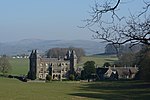Dinefwr Park National Nature Reserve
Archaeological sites in CarmarthenshireNational Trust properties in WalesNational nature reserves in WalesNature reserves in CarmarthenshireRegistered historic parks and gardens in Carmarthenshire

Dinefwr Park National Nature Reserve is an 800 acres (320 ha) estate about a mile (1.5 kilometres) from the centre of Llandeilo in Carmarthenshire owned by the National Trust, with a mansion in the centre. The highest point is occupied by the ruined Dinefwr Castle, ancient castle of the Deheubarth kingdom. It is a grade I Historic Park and a Site of Special Scientific Interest.
Excerpt from the Wikipedia article Dinefwr Park National Nature Reserve (License: CC BY-SA 3.0, Authors, Images).Dinefwr Park National Nature Reserve
Flood Plain Track,
Geographical coordinates (GPS) Address External links Nearby Places Show on map
Geographical coordinates (GPS)
| Latitude | Longitude |
|---|---|
| N 51.88 ° | E -4.016 ° |
Address
Dinefwr Park
Flood Plain Track
SA19 6RT , Llandeilo
Wales, United Kingdom
Open on Google Maps







